Maitreya Project: Nickel-Aluminum Bronze Selected for World's Largest Statue
Copper Applications in Architecture
The economic situation in Bihar State, one of the poorest areas in India, will be transformed by plans to construct the world's largest statue there. The Maitreya Project is planning to build a 500-ft (152-m)-tall, 50-story-high bronze statue of the Buddha Maitreya at Bodhgaya in Bihar.
Bodhgaya is the site of the Bodhi tree beneath which the Shakyamuni Buddha, the historical Buddha, gained enlightenment 2540 years ago. As such, Bodhgaya is one of the most important historical and spiritual sites for the world's 400 million Buddhists.

A hospital and a school meeting international standards will be built near the statue. A team of renowned architects, engineers and project managers has been assembled to undertake the design, construction and development, which will be done to the highest best-practice standards since the design brief for the project requires that the main statue must last at least 1000 years without requiring major renewal. The statue should be completed in 2005 and the school and hospital shortly afterwards. The project's estimated $150 million cost will be raised from the worldwide Buddhist community. Thousands of construction jobs will be generated, and countless indirect jobs will result from the creation of what is certain to become a major international tourist and pilgrimage destination.
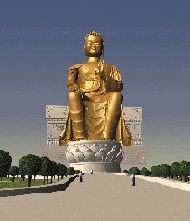
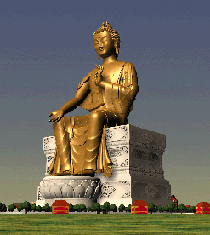
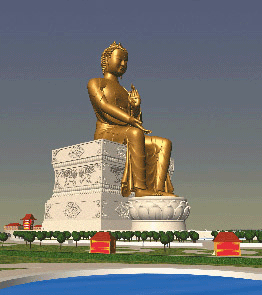
The bronze statue will sit on a 17-story-high throne containing a museum, library, theater and prayer halls. The structure is to be situated within a beautifully landscaped 40-acre site with meditation pavilions, pools and fountains set within formal gardens.
In addition to the 500-ft statue, the shrine rooms will contain 100 life-size and 360 smaller statues. The paths of the park will be lined with 100,000 cast bronze stupas (Buddhist dome- or bell-shaped memorials).
Back to TopTechinical Challenges
The project faces two major challenges: 1) designing a structure that will last for a thousand years, and 2) exact replication of the exquisite original life-size statue to the 500-ft. scale in order to retain the traditional proportions. These challenges are being met by linking 2000-year-old Buddhist art traditions with the very latest technologies.
Design and materials of construction
Since it is impossible to predict the environment and climate conditions that will prevail during the next 1000 years, the statue must be designed to withstand the worst possible conditions. After three years of extensive research, including visits to major statues throughout the world, designers decided that the statue would be constructed from an outer skin made of metal panels welded together and supported on a steel framework. (The Statue of Liberty in New York harbor utilizes a similar construction with the exception that panels are riveted to the underlying structure).
The selection of suitable materials and fabrication techniques is crucial and approaches developed for other industries that have similarly long design lifetime requirements, e.g. the nuclear power industry, have been investigated. After evaluating several metals for the outer skin, designers selected a recently developed nickel-aluminum bronze (copper 79% min, 10% aluminum, 5% nickel, 1% manganese) that is similar to the standard nickel-aluminum bronze, UNS C95800.
Back to TopWhy Bronze?
 Bronze Statue of Buddha on Lantau Island, Hong Kong
Bronze Statue of Buddha on Lantau Island, Hong KongBronze, which Tibetan Buddhists consider to be a semiprecious metal, has traditionally been used for statues of Buddha because it is relatively easy to cast. Cast bronze was used, for example, for the recently constructed statue of Buddha on Lantau Island in Hong Kong. However, there was concern that traditional statuary bronzes might have inadequate corrosion resistance for the local environment. And, while the traditional bronzes are weldable, the sheer size of the statue demanded an alloy that exhibits optimum weldability in order to simplify assembly. The addition of nickel to bronze alloys, including nickel-aluminum bronzes like C95800, increases their corro-sion resistance, strength and toughness. Alloy C95800 itself has excellent corrosion resistance and is widely used in marine applications. It is, for example, the alloy the U.S. Navy specifies for propellers. C958000 is also quite suitable for welding.
The statue's skin will have a nominal thickness of 15 mm (0.6 in) to allow ( rather generously) for any effects of corrosion over 1,000 years. At this thickness, however, it is impractical to form the panels to the required shape by hand beating, so each panel will be individuallycast in computer-machined, resin-bonded sand blocks. The statue will require more than 5,000 panels weighing a total of 2,500 tons.
An extensive testing program will ensure that the cast panels are free from defects both internally and externally. Testing will include radiography and ultrasonic methods similar to the techniques used in the nuclear and aerospace industries.
Stress analysis using computer modeling tech-niques is being undertaken to check the statue's resilience under wind loading and its resistance to earthquakes, thermal expansion and contraction, and extreme weather conditions. The advanced computer software displays different stress levels as different colors thus highlighting where stress levels are too high and a design modification is necessary.
Back to TopScaling Up
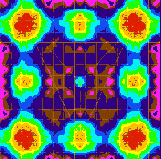 Stress Contour Plot of a Bronze Plate
Stress Contour Plot of a Bronze PlateThe statue will be scaled up from life-size original artwork created by English sculptors Denise and Peter Griffin working under the guidance of Buddhist advisors. Scaling-up the model sculpture requires state-of-the-art 3D software, robot arms, laser scanners, digital video technology and computer-controlled manufacturing techniques.
The model sculpture shown in the figure was electronically scanned to produce a digital file so that the artwork's definition could be checked visually with a computer-generated model, scaled up to full size. The digital file was also used to generate a 24-ft (7.3-m) Styrofoam model using rapid prototyping techniques.
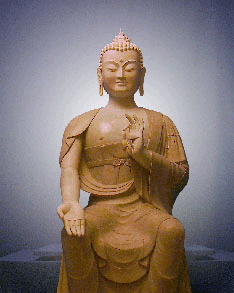 The Original Life-size Sculpture
The Original Life-size SculptureThe digital files will also be used to produce the sand molds needed for casting the bronze plates for the skin of the statue. These computer-generated molds will be very precise, yielding bronze plates that are accurate to a few millimeters (0.1 inch) and a finished statue will be a nearly exact reproduction of the original artwork.
Back to TopCurrent Status (Spring 2001)
To complete the construction of the statue within five years, work on it is going on somewhere in the world, 24 hours a day. Designs for all aspects of the project are now almost complete. Construction of the statue is scheduled to start in 2002 and when completed, the statue of Maitreya -in gleaming nickel-aluminum bronze - will be one of the new wonders of the world.
Also in this Issue:
- Phosphor Bronze: Teaching an Old Dog New Tricks
- Copper at the Cutting Edge: The Copper Vapor Laser
- Maitreya Project: Nickel-Aluminum Bronze Selected for World's Largest Statue
